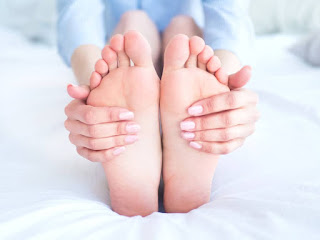High blood sugar in people with diabetes can cause many complications. One complication that is often considered trivial is diabetic foot. In diabetics, this complication can make wounds and ulcers on the feet more difficult to heal. How did it happen? Check out all information about diabetic feet in this article.
What is diabetic foot?
Diabetic foot, also known as diabetic foot / diabetic foot, is a condition that describes various complications of nerve system damage to the feet due to diabetes.
Diabetes reduces the body's ability to process the wound healing. This slow wound healing condition can cause the infection to get worse. Over time, people with diabetes can experience foot problems that cannot be cured and this condition can make the leg amputated.
One common diabetic foot problem is calluses. Although calluses may not seem alarming, if left unchecked, this condition can turn into ulcers or open wounds. People with diabetes are also at risk of developing Charcot, a condition in which the joints that support weight are progressively damaged, causing a loss of bone motion.
What causes foot diabetes?
Uncontrolled blood sugar levels in people with diabetes can cause nerves in the body to numb and lose sensation due to nerve damage. This is why people with diabetes neuropathy cannot feel pain like other normal people, who do not experience nerve damage. If the wound is not immediately examined and the infection suddenly becomes very serious, eventually amputation is needed.
People with diabetes can also experience poor blood circulation conditions on their feet, which slow down the healing process when their legs get hurt. Any wound that is slowly cured can increase the risk of infection, because bacteria can easily enter open wounds and cut wounds.
Routinely checking your feet is a very important part of treating diabetes. Unfortunately, according to an article published in the journal Diabetic Medicine, around 23-63 percent of patients rarely check their legs or even have their legs examined at all.
In fact, checking your feet is an important part of treating and preventing diabetes complications.
How can I prevent foot complications?
In addition to eating healthy foods to control blood sugar, there are several steps that diabetics can take to prevent foot complications. To increase blood flow to the lower body parts, diabetics must walk regularly using shoes that are right on the feet, comfortable and closed. If necessary, you can also buy diabetic shoes that are now on the market. Exercising also reduces hypertension and makes weight loss very important for blood circulation.
Check your feet regularly for any changes, including pain, sores, or skin ulcers. Open wounds, scratches, or foot injuries should be reported to the doctor immediately. To keep your feet healthy, follow these tips:
Check your feet every day, including between your toes.
Visit a doctor if you see cuts, open wounds, deep sores, ulcers, redness, swelling, hot or defective areas.
Don't walk barefoot, even around the house. Small wounds can turn out to be a big problem. Walking on hot sidewalks without shoes can cause damage that might not be felt.
Don't smoke, because it narrows blood vessels and contributes to poor blood circulation.
Keep your feet clean and dry, Don't soak your feet. Dry your feet; do not rub.
Moisturize after cleaning, but not between toes.
Avoid hot water; check the temperature of the pool water with your hands, not your feet.
Cut toenails after bathing. Cut straight and then smooth with a nail file gently. Check the sharp edges and cuticles that have never been cut.
Use pumice to relieve calluses. Never cut off calluses yourself, or use chemical drugs on the market.
Visit a podiatrist for additional nails and fine care.
Wear shoes properly and fibrous socks (for example, cotton or wool). Don't wear new shoes for more than one hour at a time and check your feet carefully after removing your shoes. Check in your shoes for areas that stand out or have other objects before you wear them.
Avoid high heels and shoes with pointed ends.
If your feet are cold, warm them with socks.
Shake your toes and move your ankles while sitting, especially for long periods of time.
Don't cross your legs, because this can inhibit blood flow.
Keep your feet and lift your legs if you have an injury.
The possibility for diabetics to avoid foot complications can occur if they are diligent and maintain healthy blood sugar levels. However, daily foot checks are also important.
Langganan:
Posting Komentar (Atom)
Buy American Superheroine Movie HD And No Cut Version
Trailer Superheroine American Version Buy American Superheroine Movie HD And No Cut Version Get a superheroine movie collection of movies wi...
-
Heroine Pinch Omnibus 04 Sun Warrior Leona V Title number ZDAD-60 Starring actress Nori Okawa Directed by Miki Matsuura Series Heroine Pinch...
-
UNDERACTIVE THYROID An underactive thyroid (or hypothyroidism) is where your thyroid gland doesn't produce enough hormones. The thyroid...
-
Best Muslim Hadith Having told us Harun bin Ma'ruf told us Abdullah bin Wahb had told me 'Amru bin Harith that Abu Yunus slave Abu H...
-
Cavities are conditions that indicate damage to tooth enamel, aka the hard outer layer of the teeth. This condition can be a problem in chil...
-
Heroine Pinch Omnibus 12 Solar Warrior Leona Lamp Majin Aradine Title number ZDAD-98 Starring actress Nori Okawa Directed by Miki Matsuura S...
-
Get to know Crown Dental Procedures, Functions, and Various Types Crown teeth or dental crowns are procedures for installing dental sheaths ...





Tidak ada komentar:
Posting Komentar